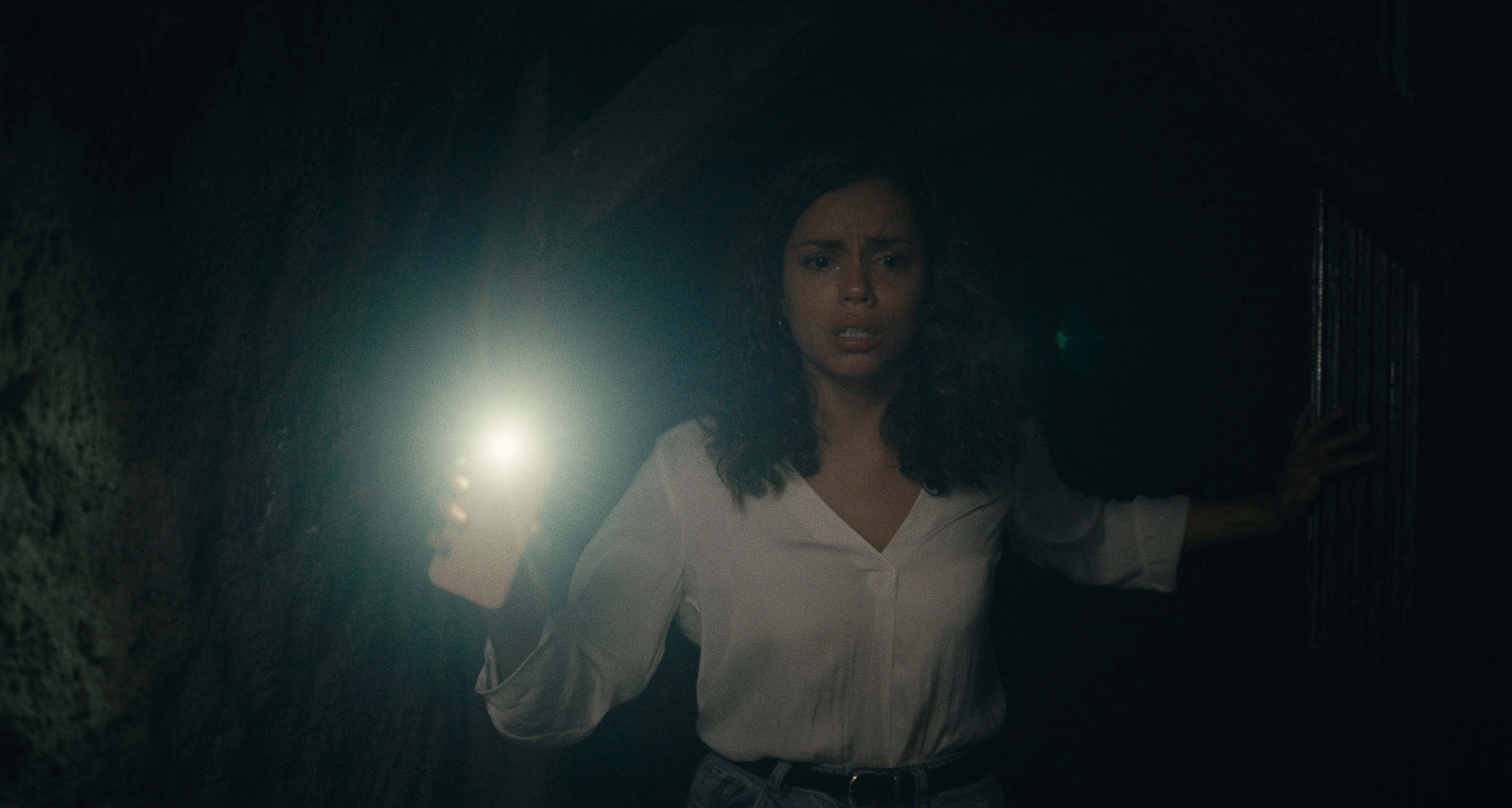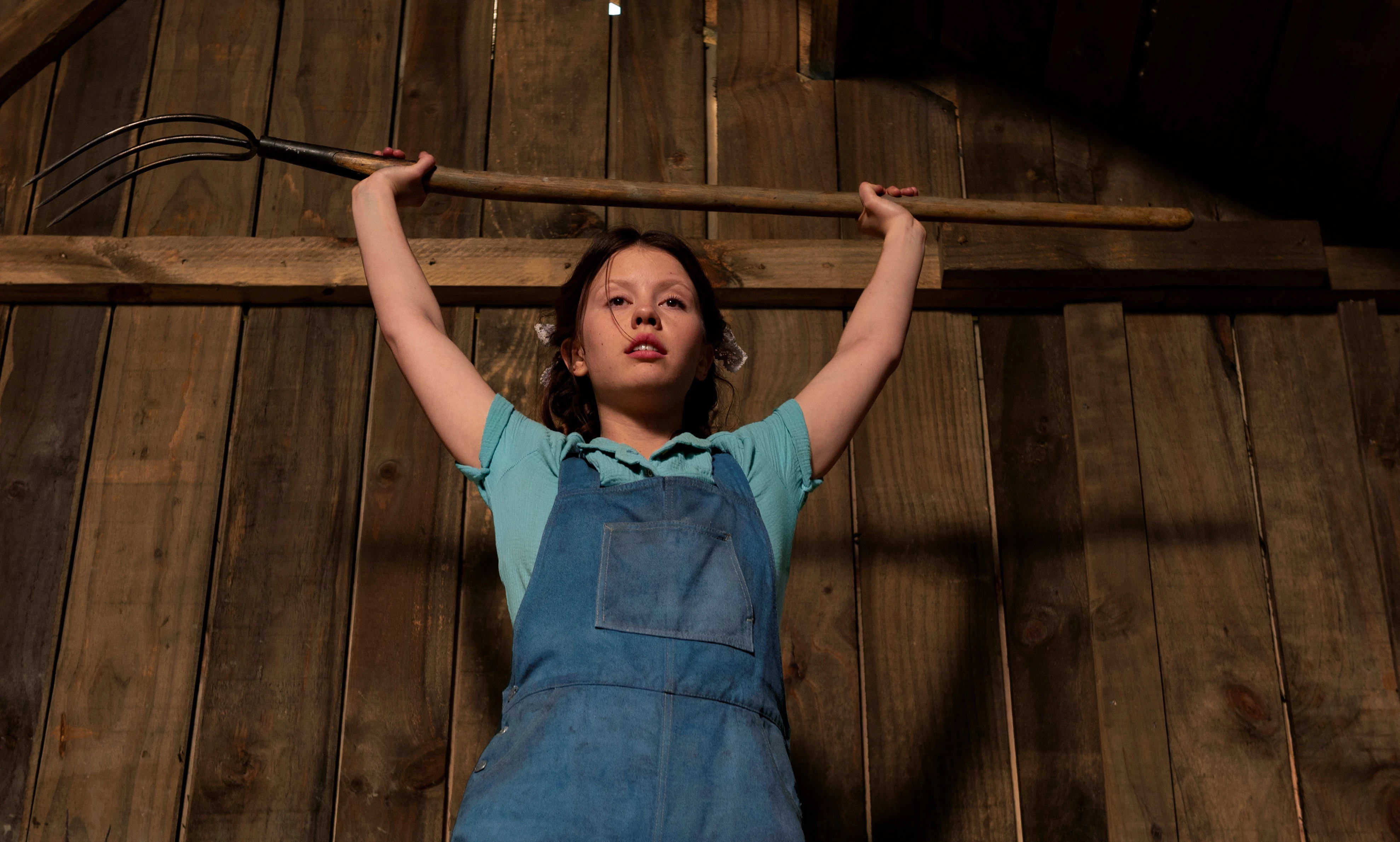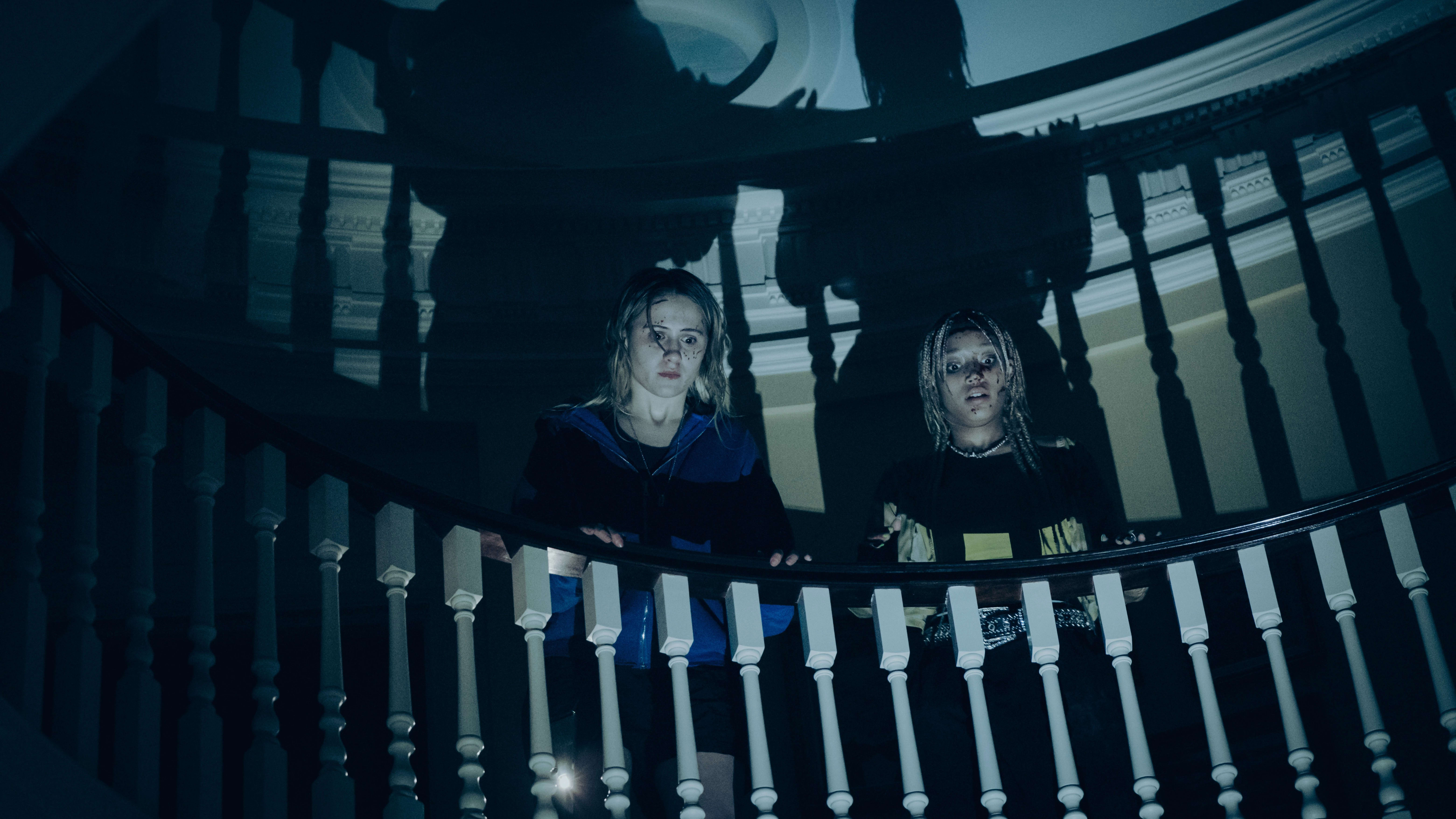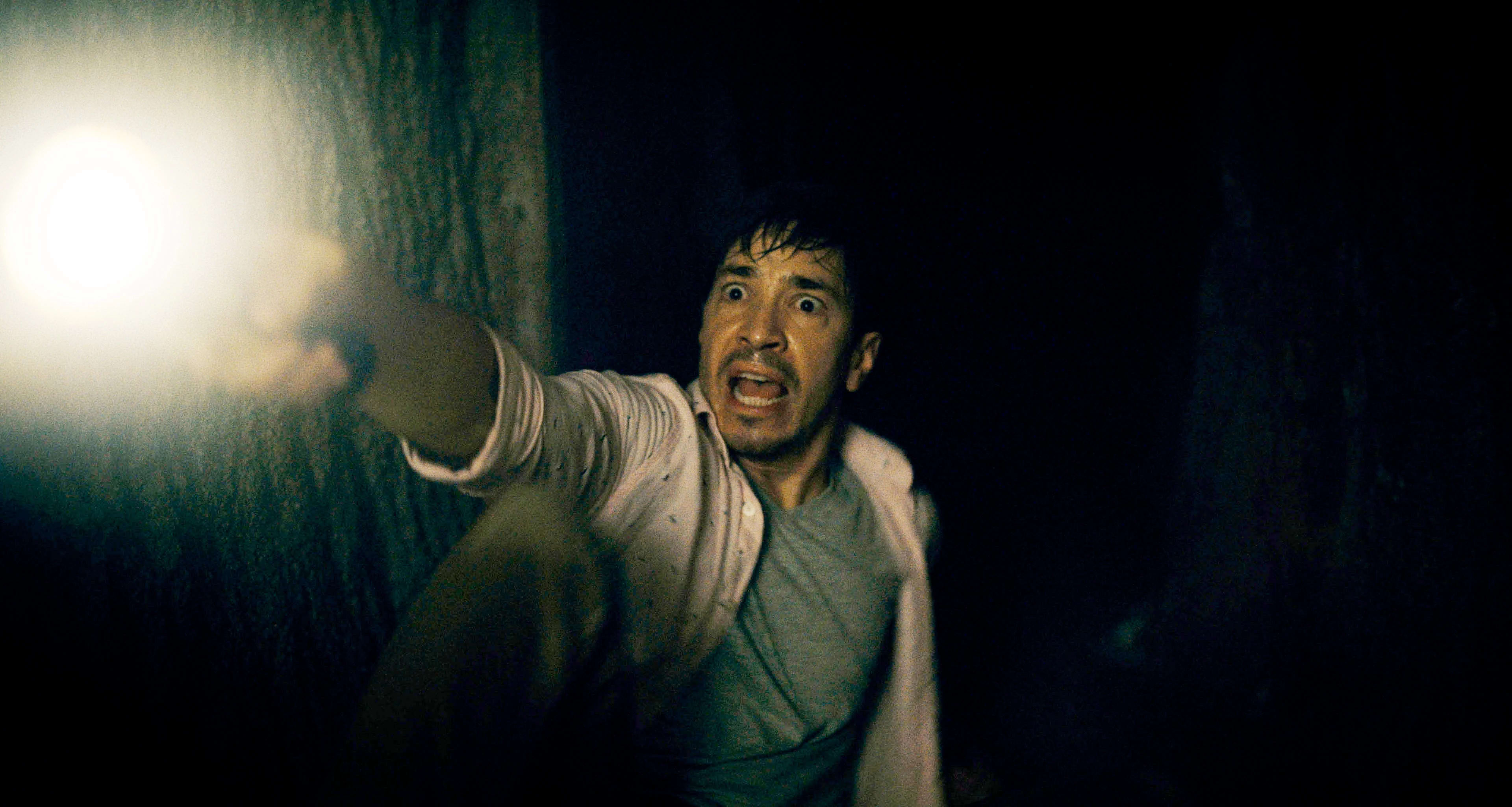A look at SVA alumni working in the horror genre, from the fall/winter 2023 ‘Visual Arts Journal’

Georgina Campbell in Barbarian (2022), written and directed by Zach Cregger (BFA 2004 Computer Art).
Producing Final Girl Power
Have you heard about the SVA alumnus–helmed horror trilogy making a (bloody) splash in the film industry? Its fans include none other than Martin Scorsese, who wrote in a review that, after watching its second installment, “I had trouble sleeping.” If not, the opening scene of the first movie in the series, 2022’s X, leaves no doubt that you’re in for a nightmarish ride. Cops circle a body in a farmhouse’s front yard, with a red carpet of blood stretching up the porch steps.
To make X, its prequel Pearl (2022) and the forthcoming MaXXXine, writer–director Ti West teamed up with his frequent producing partner Peter Phok. The two began working together while still at SVA—both are BFA 2003 Film and Video alumni—but hadn’t collaborated in the past few years. In that time, Phok continued to produce horror films, as well as video games, while West directed episodic TV.
“What attracted me to X is I just have such implicit trust in Ti, and he hadn’t written a horror movie in quite some time,” Phok says. But he’s also just a fan of the genre: “I feel like I can’t escape horror because I still enjoy it so much.”
Mia Goth in Pearl (2022), written and directed by Ti West and produced by Peter Phok (both BFA 2003 Film and Video).
West’s trilogy is one of the more ambitious multi-film projects in recent memory, let alone within the horror genre. Each chapter takes its stylistic cues from a different era of film. In X, six would-be stars—including our heroine, Maxine (Mia Goth)—set out to make a pornographic film (but an “artistic one,” one of them insists) on the cheap in rural Texas, 1979, only to be terrorized by an elderly farm wife, Pearl (also played by Goth), and her husband, Howard. It’s a plot reminiscent of pulpy ’70s features like The Texas Chainsaw Massacre (1974), and X’s film-within-the-film adopts a similarly low-budget look. Pearl, released six months later, covers the title character’s early 20th-century origins in the fashion of a melodrama from Hollywood’s Golden Age, with references to the earliest days of filmmaking. MaXXXine, due sometime in 2024, will pick up Maxine’s story in 1980s Los Angeles.
Written by Goth and West, Pearl was shot at the same time as X, which presented a unique situation not just for director and star, but for Phok as well. Simultaneously making two movies with opposite aesthetics during a pandemic wasn’t easy, but all that is just part of the producer gig, Phok says. “I think that we [producers] kind of don’t see a problem that’s too big. . . . That’s the job, right? It’s problem-solving.”
It’s not the gore that makes these movies fascinating, or even what really makes them truly frightening. West excels at quick character sketches and manipulating expectations, a skill Phok says West honed through his TV work. In X, an aerial shot traces an alligator cutting through the water after the serenely drifting Maxine. In another scene, the camera peers through the shadowy spindles of a banister at Goth’s two characters, Maxine and Pearl, young and old, who stand side by side reflected in a mirror. And Pearl culminates in a 15-minute monologue as riveting as any scenes of ghosts, monsters or murdery mayhem.
Ultimately, while the series follows certain slasher-film traditions, “it’s so much more than that,” Phok says. “It had something to say.”
Laughing So Hard We’re Crying
Director Halina Reijn’s Bodies Bodies Bodies (2022) is another recent horror film that is fuller-bodied than its formulaic counterparts. Not only does it have something to say about the moral rot among ultra-rich and Internet-savvy youth, its snarky characters have plenty to say themselves—more than even the script provided.
When editor Taylor Levy (BFA 2012 Film and Video) started working with the footage, he was struck by how it challenged genre boundaries. “Wow, this is a lot funnier,” he recalls thinking, comparing the results to the already-humorous script. “Everyone’s improv-ing. Rachel [Sennott]’s improv-ing. Pete [Davidson]’s improv-ing.” Levy decided to lean into the humor with his edit, including as much improvisation as he could so that he and Reijn had plenty of directions available for where to take the film.
From left: Maria Bakalova and Amandla Stenberg in Bodies Bodies Bodies (2022), edited by Taylor Levy (BFA 2012 Film and Video).
Joining West’s X series as another of distributor A24’s quirky titles, Bodies follows a group of 20-somethings partying at one of their parents’ mansions on the night of a big storm. They decide to play a game, also called “Bodies Bodies Bodies,” that has caused drama among some of them in the past. Of course, the power cuts out. Of course, a corpse is found. Of course, all the dirty secrets and barely repressed rivalries emerge to challenge their relationships. As the body count increases, the truth about what everyone thinks of everyone else oozes out. In a film where the most scathing insult is “Your parents are upper middle class,” satire is as much a key element as the jump scare.
Levy came to SVA as a transfer student. “I felt like proximity [to the industry] would have a lot of effect on the potential of my path.” An internship at Post Factory New York launched his career, but he also tapped into his passion for the power of editing on campus, where fellow students were shocked that he was willing—eager, even—to face the terror and long hours of cutting together their movies with them.
Editing horror is different from editing other genres, Levy says, in that everything needs to feel a bit “jagged.” Perhaps because of the primacy of fear, simple, even unsurprising choices can have near-magical effects: “You put one little bloody sound on, and the whole thing comes to life. In dramas, you don’t really run into that so much.”
This Is the “Craziest Thing to See Next”
It might be as much of a surprise to writer–director Zach Cregger (BFA 2004 Computer Art) as it is to fans of his 2022 horror hit, Barbarian, that he started his career in comedy. As an undergraduate, Cregger co-founded a student club that put on sketch shows on campus and in local venues. In Cregger’s telling, it started as something of a lark, more of an excuse to get together with friends than anything else.
“I love comedies like I love all kinds of films,” he says, “but I never really saw myself as a comedian.”
Regardless, after college he, Sam Brown (BFA 2004 Film and Video), the late Trevor Moore (BFA 2003 Film and Video) and non-SVA members Darren Trumeter and Timmy Williams, continued with the group, billed as The Whitest Kids U’ Know, ultimately producing, writing and starring in an eponymous series for the Fuse and IFC channels. In 2009, he and Moore wrote, directed and starred in a feature-length comedy, Miss March. Unlike their series, it was poorly received. “I thought nobody ever wanted to hear from me again as a filmmaker,” Cregger says, “so I stuck to just acting for the next five to seven years.”
Justin Long in Barbarian (2022), written and directed by Zach Cregger (BFA 2004 Computer Art).
Eventually, he began writing scripts, exploring a variety of genres that reflected his own wide-ranging taste. One was Barbarian, which tells the story of a young woman whose Airbnb rental goes increasingly, horrifyingly wrong. Its narrative unpredictability—with sudden shifts in tone, setting and viewer sympathies—mirrors Cregger’s intuitive approach to writing it.
“I kept asking myself, ‘What would be the craziest thing to see next?’” he says. “I didn’t know the ‘Mother’ [character] existed until she appeared. I thought [the Keith character] was going to be the bad guy, and then I realized I had nothing for him to do.
“I don’t know if I would recommend that approach to other writers,” he adds, but in this case, it paid off. Though it took Cregger two years to find a studio for the project and he was limited to a $4.5 million budget, when it was finally released last October—starring Georgina Campbell, Justin Long and Bill Skarsgard—Barbarian was a critical and commercial success, making him one of the most in-demand young filmmakers in Hollywood. This fall, he starts filming his next project, a horror film called Weapons, and he’s also producing two films (one horror, one science fiction) and in the early stages of developing a fourth.
Pick Your Pattern: Polka Dots or Blood Splatter?
Few things elicit a visceral reaction better than blood, something that Meaghan Cleary (BFA 2015 Film) knows well. Cleary—whose dark-comedy script Latchkey Kids is in pre-production—worked as the costume designer for the upcoming horror film Consumed. Behind the scenes, “one day’s outfit” for the story’s hero, a hiker in the woods played by Courtney Halverson, was actually “nine costumes,” Cleary says. “All the same look, but with different stages of bloodiness.”
Since graduating, Cleary has worked in costume design for television and film. Before a single garment is stitched, she reviews the script to make an inventory of what will be needed and then gets to know the director’s vision. Genre plays a big role in determining the materials and color schemes, elements that matter on both symbolic and practical levels, she says. For example, when designing the costume for a “wild man” character, played by Devon Sawa, Cleary also had to consider the actor’s ability to do all of his stunts.
“I took a note from Game of Thrones and used some faux-fur carpets that I had cut and sewn together to make it look like it was from multiple animals,” she says. Halverson’s character, meanwhile, was dressed in yellow, “to make her a bit more of a target in her environment—she was the prey of the monster.”
Who Are the Real Monsters?
Skunk Bite (2023), a horror short written by and starring Kelly Quinn and directed by Quinn and Grace Pomilla (both BFA 2023 Film).
The success of pictures like Robert Eggers’s The Witch (2015), Bong Joon-ho’s Parasite (2019) and Jordan Peele’s Get Out (2017) and Nope (2022) have shown the genre’s still-untapped potential to subvert stereotype and engage with social issues.
“Fortunately, writers and directors have been creating films with strong female and/or POC leads that don’t die within the first 10 minutes, like in every ’80s or ’90s thriller,” says Kelly Quinn (BFA 2023 Film), whose thesis project, a horror short called Skunk Bite, co-directed with classmate Grace Pomilla, screened at this year’s SVA Premieres showcase in Los Angeles. For Skunk Bite, “I wanted to create a female-centric story,” she says. “My main character, Campbell, is a strong character with a hunger for revenge.”
Looking at films like last year’s Everything Everywhere All at Once, Phok has hope for the future of diversity in filmmaking. “If you support stories from other cultures and stories that basically haven’t had the opportunity to be widely told,” he says, “you’ll find that there’s an audience for it.”
A version of this article appears in the fall/winter 2023 Visual Arts Journal.
SVA alumnus Kelly Quinn in Skunk Bite (2023), a horror short she wrote and co-directed with Grace Pomilla (both BFA 2023 Film).






